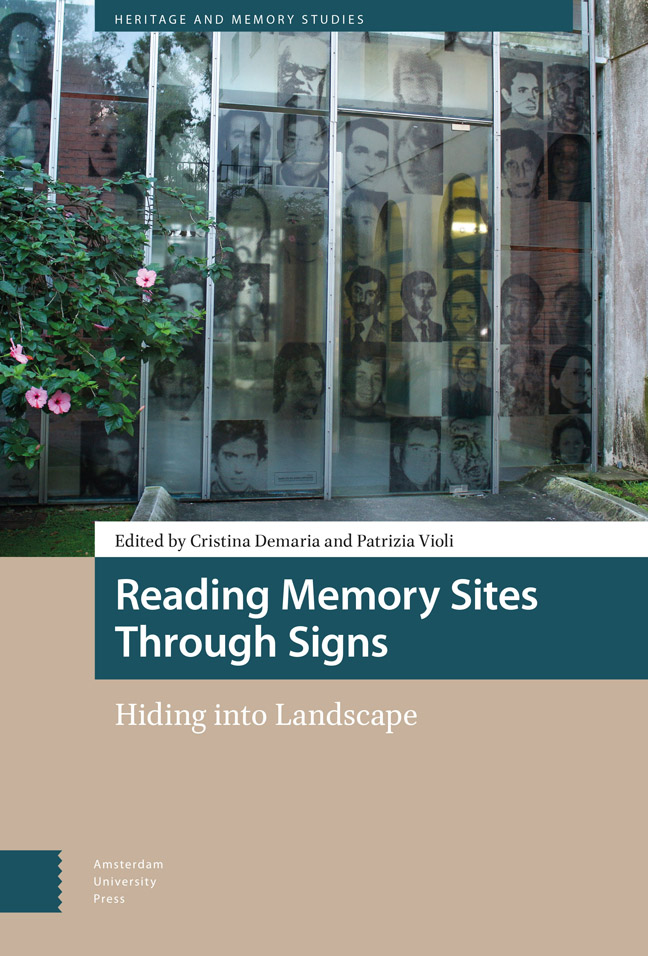Book contents
- Frontmatter
- Contents
- List of Illustrations
- For a Semiotics of Spaces of Memories: Practices of Enunciation and Narratives from Monuments to Global Landscapes of Inheritance
- 1 Stories that Shape Spatialities: Lieu and Milieu de Mémoire through the Lens of Narrativity
- 2 Interpretation and Use of Memory: How Practices Can Change the Meanings of Monuments
- 3 Uncomfortable Memories of Fascist Italy: The Case of Bigio of Brescia
- 4 What Does Fascist Architecture Still Have to Tell Us?: Preservation of Contested Heritage as a Strategy of Re-Enunciation and ‘Voice Remodulation’
- 5 Berlin, the Jewish Museum and the Holocaust Memorial
- 6 Making Space for Memory: Collective Enunciation in the Provincial Memory Archive of Córdoba, Argentina
- 7 Ruins of War: The Green Sea and the Mysterious Island
- 8 Turning Spaces of Memory into Memoryscapes: Cinema as Counter-Monument in Jonathan Perel's El Predio and Tabula Rasa
- 9 Voices from the Past: Memories in a Digital Space: The Case of AppRecuerdos in Santiago, Chile
- 10 500,000 Dirhams in Scandinavia, from Mobile Silver to Land Rent: A Semiotic Analysis
- Index
- Index of Names
6 - Making Space for Memory: Collective Enunciation in the Provincial Memory Archive of Córdoba, Argentina
Published online by Cambridge University Press: 17 February 2024
- Frontmatter
- Contents
- List of Illustrations
- For a Semiotics of Spaces of Memories: Practices of Enunciation and Narratives from Monuments to Global Landscapes of Inheritance
- 1 Stories that Shape Spatialities: Lieu and Milieu de Mémoire through the Lens of Narrativity
- 2 Interpretation and Use of Memory: How Practices Can Change the Meanings of Monuments
- 3 Uncomfortable Memories of Fascist Italy: The Case of Bigio of Brescia
- 4 What Does Fascist Architecture Still Have to Tell Us?: Preservation of Contested Heritage as a Strategy of Re-Enunciation and ‘Voice Remodulation’
- 5 Berlin, the Jewish Museum and the Holocaust Memorial
- 6 Making Space for Memory: Collective Enunciation in the Provincial Memory Archive of Córdoba, Argentina
- 7 Ruins of War: The Green Sea and the Mysterious Island
- 8 Turning Spaces of Memory into Memoryscapes: Cinema as Counter-Monument in Jonathan Perel's El Predio and Tabula Rasa
- 9 Voices from the Past: Memories in a Digital Space: The Case of AppRecuerdos in Santiago, Chile
- 10 500,000 Dirhams in Scandinavia, from Mobile Silver to Land Rent: A Semiotic Analysis
- Index
- Index of Names
Summary
Abstract
This essay aims at showing how the concept of enunciation can be used to analyse places, by deploying it in the analysis of a museum in Córdoba, Argentina, located inside a former clandestine centre of detention and torture.
The concept of enunciation will prove useful to look at two crucial dimensions of this place of memory: the multiplicity of voices and perspectives that it embodies, together with the display of many different traces of what happened in it. My hypothesis is that both these mechanisms are used to convey a stronger ‘effect of reality’ for the story told, reinforcing each other with mutual connections and shaping a precise narrative of the past.
Keywords: Memory Places; Enunciation; Traces; Museum; Archive; Dirty War
Introduction
The museum known as the Provincial Memory Archive in Córdoba, Argentina (Archivo Provincial de la Memoria, from now on: APM1) is located in a lovely building in the heart of the city's old town. For decades, the building housed the intelligence department of the Córdoba police, also called D2, which in the 1970s worked as a clandestine centre of detention and torture (from now on: CCDT). Nowadays, it hosts a museum and an audio-visual archive of testimonies about its past.
As such, the place is connected to the memory of the atrocities committed by the civilian-military dictatorship that took place in Argentina from 1976 to 1983, enacted by a military council that reunited the chiefs of different armies, self-defined as the National Reorganisation Process. The period is also known as the Dirty War, named after the terrible methods used by the state to destroy any sort of opposition and stay in power for almost seven years. The most common of such means was the disappearance of people: 30,000 men and women were illegally and secretly killed by the state, after having been kidnapped, detained in inhumane conditions and then buried in common graves or thrown into the sea. In this context, in which the state put in place what can be called an invisibility strategy for its own actions (Violi 2015), the search for and discovery of the traces of what happened has been one of the constant objectives of human rights associations from the first days of the restoration of democracy.
- Type
- Chapter
- Information
- Reading Memory Sites through SignsHiding into Landscape, pp. 163 - 182Publisher: Amsterdam University PressPrint publication year: 2023



